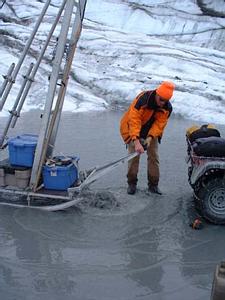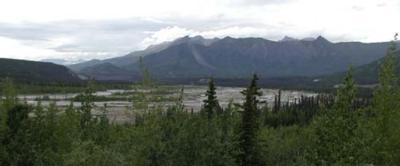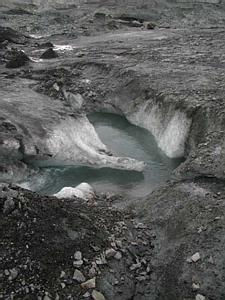5 August, 2000
August 5 , 2000
Matanuska Glacier, Alaska
There was an interesting event that occurred during the drilling today.
The new drill sites are located on the low flat ice sheet near the
Mammoth Vents. This ice sheet is probably no more than three or four
feet above the “lake” that is produced by these vents. In both holes
that were bored today geysers of water maybe a foot high shot up through
the holes. I suppose that given the location near the vents that it
should have been anticipated but it caught everyone off guard. Some
people who weren’t there when it happened made a special trip out to
have a look. Ben and I are now curious about whether or not our dye
would come out this “man-made vent”. It will be intetresting to see if
frazil ice terraces form around them.
I had quite a bit of free time today and spent some time hiking up above
the seracs by the glacial lake. On my way back I stopped to look at
several moulins. It seems like something really odd is going on. The
moulins all seem to be backed up like they’re clogged somehow. A couple
of them even had pools just a couple feet below the ice rim. It’s odd
because the melting of the ice doesn’t seem to be as high as it was a
few weeks ago. The surface runoff into these moulins is not nearly as
high as it had been. A number of people have remarked that it’s been an
unusual melt season this year and I’ve heard a local resident complain
about the lack of the usual summer weather they are accustomed to. Maybe
something unique will happen.
During the summer melt season the rivers that drain glaciers experience
a drastic rise in water level. The levels can change quite a bit during
a given twenty-four hour period as well as from day to day. The valleys
below a glacier are broad and very flat and the streams produce numerous
gravel bars. After several warm sunny days the streams rise up and
occasionally over these gravel bars and new ones are produced as the
water recedes once again. The result is something called a braided
river. There is an aerial photo of the drainage just below the Matanuska
Glacier in my July 26 journal. In that picture you get a good idea of
why they have that name. Because these rivers are so wide they can
handle a significant rise in water volume and yet not increase in height
very much. However, with the higher levels comes a whole new appearance
to the resulting gravel bars. There are several whitewater rafting
companies that capitalize on the summer flow. It appears to be a nice
safe river for family trips with long standing wave trains that are big
enough to get occupants wet and provide a fun ride but small enough to
keep everyone in the raft. All the outfitters provide dry suits to keep
the parcticipants protected from the icy splashes. During the winter
there is very little water flowing in these streams. What does flow is
from groundwater sources.
We’re still waiting for the dye to get here from the CRREL office in
Anchorage. As soon as it arrives we will be resuming our dye tests. I’m
anxious to get them started again especially now with our “man made
vents” gushing forth.
Marvin Giesting

Isaac Larsen prepares to hitch the drill rig as water gushes from the new hole.

This is the same area of braided river as in the aerial photo from the July 26 journal. As you can see it is very wide and flat.

This is the same moulin that we've been dumping our dye into recently. Compare this picture to the one on July 27. Something's up!
Contact the TEA in the field at
.
If you cannot connect through your browser, copy the
TEA's e-mail address in the "To:" line of
your favorite e-mail package.
|
